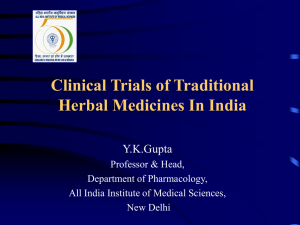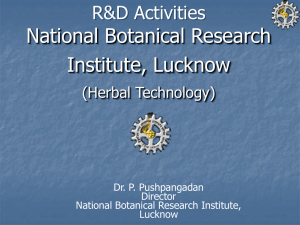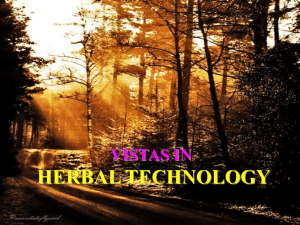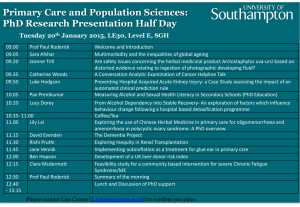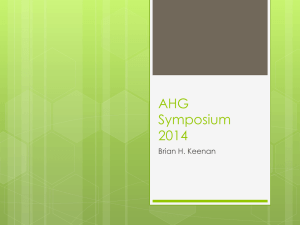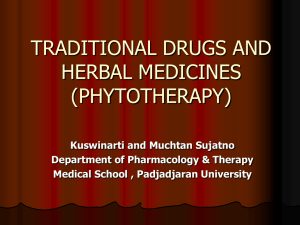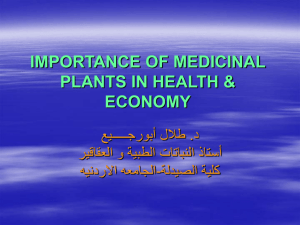Regulatory Issues for Traditional Medicine
advertisement
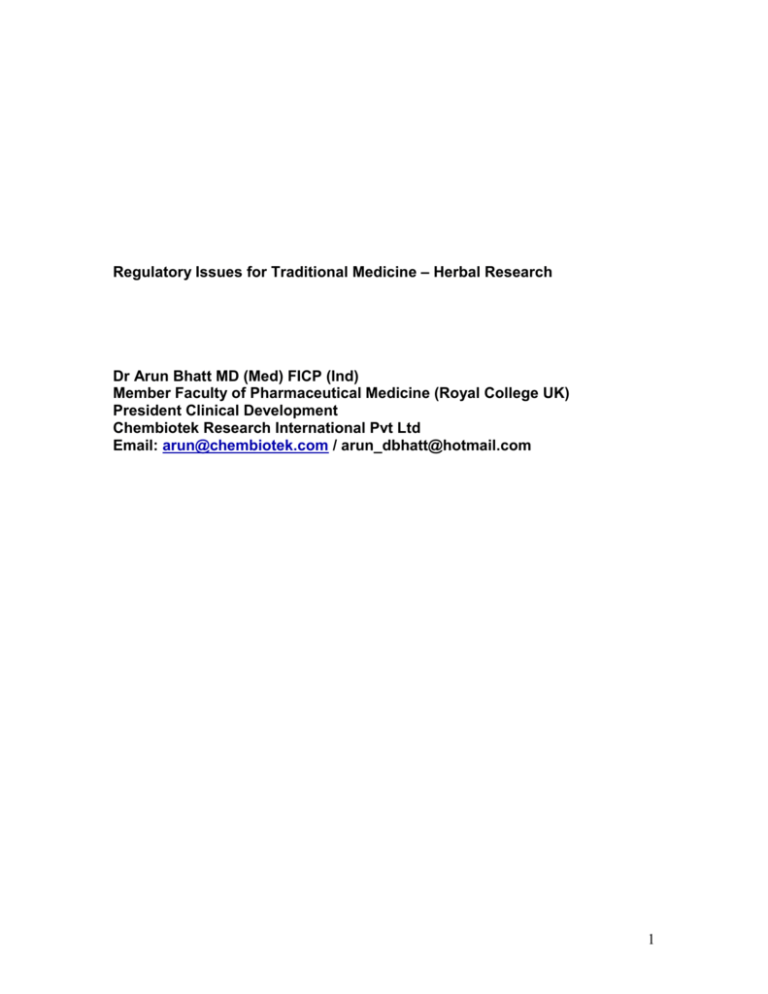
Regulatory Issues for Traditional Medicine – Herbal Research Dr Arun Bhatt MD (Med) FICP (Ind) Member Faculty of Pharmaceutical Medicine (Royal College UK) President Clinical Development Chembiotek Research International Pvt Ltd Email: arun@chembiotek.com / arun_dbhatt@hotmail.com 1 Introduction Traditional medicine is a broad term encompassing health practices, approaches, knowledge and beliefs which incorporate herbal, animal and mineral based medicines, spiritual therapies, manual techniques and exercises, applied singularly or in combination to treat, diagnose and prevent illnesses or maintain well-being. 1 There has been a lot of interest, today, in the traditional medicine for its potential contribution to health care. However, there are a lot of concerns about the traditional medicine in areas of efficacy, safety and quality. Several organisations have discussed these issues in their approach papers. A recent WHO fact sheet comments “ Unregulated or inappropriate use of traditional medicines and practices can have negative or dangerous effects.” 1 Our own National Policy 2001on Indian Systems of Medicine includes issues such as drug standards, regulations and enforcement’ and focuses the research agenda on clinical trials, pharmacology, toxicology, and drug standardization. Among the traditional approaches, herbal medicines present unique challenges in research and regulations. Recent reviews have focused on the problems of quality, issues of clinical research, and need for new regulations for herbal therapies. 2-5 In recent years, several regulatory guidelines are available in the area of herbal medicines. 6-8 This article is a brief review of the regulatory issues in traditional medicine herbal research. Current regulatory issues for herbal medicines There are several regulatory concerns in relation to research applications and commercialization of herbal medicines. Standardization of herbal drugs For safe and effective use of herbal drugs, consistency in composition and biologic activity are essential requirements. However, herbal drugs frequently fail to meet this standard, as there are problems such as 1) difficulties in identification of plants, 2) genetic variability, 3) variations in growing conditions, 4) diversity in harvesting procedures and processing of extracts, and 5) the lack of information about active pharmacologic principles. 2 The use of chromatographic techniques and marker compounds for the standardization of herbal products can ensure batch-to-batch consistency; however, this does not ensure consistent pharmacologic activity or stability. With herbal medicines what is on the label and what is in the bottle may differ considerably. In a study of ginseng preparations, the amount of ginsenosides varied from 11.9-327.7% of the amount on the label. 3 Medical letter cautions, "Their (herbal medicines) potency may vary and their purity is suspect," 9 Australian medicines regulatory body the Therapeutic Goods Administration, suspended production license of Pan Pharmaceuticals after an audit, which revealed problems with company's quality control standards. 10 The Lack of standardization of herbal drugs would be a serious problem for a researcher as he would not be able to rely on commercially available herbal products for his research studies. Quality of herbal preparations If an herbal remedy is effective, quality assurance is needed to ensure that the product has the expected effects. Even in the absence of data on efficacy, quality assurance is important, as quality is a critical determinant of safety as well.4. Adulteration of plants is serious problem. Some of the common adulterants are: botanicals, toxic metals, microorganisms, microbial toxins, pesticides, and fumigation agents. A US investigation reported that 32 percent of marketed Asian patent medicines contained undeclared pharmaceuticals or heavy metals. 2 The drugs most frequently found were ephedrine, chlorpheniramine, methyltestosterone, and phenacetin; 10 to 15 percent contained lead, mercury, or arsenic. The incidence of heavy metal contamination is not known, but one study showed that 64% of samples collected in India contained significant amounts of lead (64% mercury, 41% arsenic and 9% cadmium). 11 This can cause serious harm to patients taking such remedies and could confound the assessment of safety in a clinical trial. Quality has to be assured at all stages – herbal raw materials, processing of herbals and finished herbal medicines 2 Evidence of Clinical Efficacy Scientific evidence from randomized clinical trials is only strong for many uses of acupuncture, some herbal medicines and for some of the manual therapies. 1 Only a small fraction of the thousands of medicinal plants used worldwide has been tested rigorously in randomized, controlled trials. Even if the animal studies or anecdotal clinical experiences are promising and use of an herb is widespread, such observations cannot predict the results of well designed randomized, controlled trials. A recent review concluded that evidence-based studies on the efficacy and safety of traditional Indian medicines are limited. 12 The data available is mostly experimental or in animals. Most trials do not report hard efficacy endpoints and duration of observation periods is generally short. The clinical relevance of the observed effects is not always clear. 5 For instance, most Indian trials of hepatoprotectice agents are open and uncontrolled. As most acute liver conditions have a natural recovery, it is difficult to link the improvement to the herbal product. 13 The essential ingredient in most formulations is not precisely defined. High quality studies are necessary to evaluate and compare the value of traditional Indian drugs to modern medicine. 12 A fundamental problem in all clinical research of herbal medicines is whether different products, extracts, or even different lots of the same extract are comparable and equivalent. For example, Echinacea products can contain other plant extracts; use different plant species (E. purpurea, pallida or angustifolia), different parts (herb, root, both), and might have been produced in quite different manners (hydro- or lipophilic extraction). Even different species may be known by the same name in local language. Brahmi refers to Centella asiatica and Bacopa monniera. The herbal industry is not required to conduct clinical trials, and the industry professionals argue that it would be not be possible to recover the high research costs, as herbal products can not be patented as easily as new chemical entities. Nevertheless, randomized, controlled trials are the best way to demonstrate the efficacy of any medicine, herbal or conventional. 4 Safety Concerns - Adverse Reactions and Drug Interactions Herbal medicines are generally considered comparably safer than synthetic drugs. While this may be probably correct, case reports show that severe side effects and relevant interactions with other drugs can occur. For instance, the herb Ephedra marketed as a dietary aid in USA, led to at least a dozen deaths, heart attacks and strokes. 14 Other well-known safety issues have been hepatotoxicity of kava and renal effects of aristolochic acid. 14 Besides, drug interactions of herbal drugs are of a serious concern. For example, hypericum extracts can decrease the concentration of a variety of other drugs by enzyme induction. Serious adverse effects have been reported when the addition of St. John's wort caused serum levels of cyclosporine and antiretroviral agents to fall to sub therapeutic levels. Garlic is reported to increase clotting time in patients taking warfarin. Lack of regulatory standards regarding the efficacy and safety of herbal products did not arouse much concern in the past, as these products were often perceived as so safe that even if they were ineffective, little harm resulted. 14 However, the situation is changing now and there is an increasing body of literature on the side effects and interactions of herbal medicines.15-16 Besides the direct risks of adverse effects and drug interactions there is an indirect risk that an herbal remedy without demonstrated efficacy may compromise, delay, or replace an effective form of conventional treatment. 4 WHO has urged the governments to establish regulatory mechanisms to control the safety and quality of products. 1 Global Regulatory Scene The above issues have led to an increasing regulatory focus on herbal products in US and Europe. 6-7 US FDA Guidance for Botanicals The US FDA has issued draft guidance for botanical products.6 The regulatory approach is based on 1) intended use of botanical – as dietary supplement, cosmetic or drug and 2) status of 3 botanical – marketed in US, marketed outside US or not marketed at all. The guideline is fairly exhaustive and pragmatic. The data requirements depend on several factors (Table 1). Some of the general guidelines are: Traditional herbal medicines or currently marketed botanical products, because of their extensive though uncontrolled use in humans, may require less preclinical information to support initial clinical trials than would be expected for synthetic or highly purified drugs. Requirements for Investigational New Drug (IND) applications of botanicals legally marketed in the United States as dietary supplements or cosmetics Very little new chemistry manufacturing and controls (CMC) or toxicologic data are needed to initiate early clinical, if there are no known safety issues associated with the product and it is used at approximately the same doses as those currently or traditionally used or recommended. As the product is marketed and the dose thought to be appropriate and well tolerated is known, there should be little need for pilot or typical Phase 1 studies. Sponsors are allowed to initiate more definitive efficacy trials early in the development program. If there is doubt about the best dose of the product tested, a randomized, parallel, dose-response study may be particularly useful as an initial trial. Requirements for botanical product that has not been previously marketed in the United States or anywhere in the world Certain additional information (CMC, toxicology, human use) is required to assist FDA in determining the safety of the product for use in initial clinical studies. If the product is prepared, processed, and used according to methodologies for which there is prior human experience, sufficient information may be available to support such studies without standard preclinical testing. Clinical trials of botanical products There may be special problems associated with the incorporation of traditional methodologies, such as selection of doses and addition of new botanical ingredients based on response, which will need to be resolved. The credible design for clinical trials studies will be randomized, double blind, and placebo-controlled (or dose-response). For most conditions potentially treated by botanical drugs (generally mildly symptomatic), active control equivalence designs would not be credible. For expanded i.e., Phase 3 clinical studies on a botanical drug product, more detailed information on CMC and preclinical safety is necessary as compared to the information required for a Phase 1 or Phase 2 study. This additional information should be provided regardless of whether the product is currently lawfully marketed in the United States or elsewhere as a dietary supplement. All study data should conform to standard ethical guidelines of good clinical practice (informed consent, approval from ethics committee) for all clinical trials. Documentation for early trials (IND) Description of Product and Documentation of Human Use Description of Botanicals Used History of Use Current Investigational Use Chemistry, Manufacturing, and Controls 4 Botanical Raw Material Botanical Drug Substance Botanical Drug Product Placebo Labelling Environmental Assessment or Claim of Categorical Exclusion Pharmacology/Toxicology Information Exclusive marketing rights US FDA has a provision to grant exclusive marketing rights for 3-5 years even in the absence of patent protection. During the period of exclusivity, FDA will not approve, or in some cases even review, certain competitor products unless the second sponsor conducts all studies necessary to demonstrate the safety and effectiveness of its product. European Guidelines on Herbal Medicinal Products The data requirements in the European Guidelines depend on the nature and level of indication and available clinical literature. 7 The guidelines provide grading of recommendations based on previous clinical trial data. The level of safety must correspond to the indication claimed for the product. The review of literature should identify the current level of evidence for safe and effective use of herbal medicine. For minor indications, a low level of evidence (expert opinions or clinical experience of respected authorities) is acceptable if there is support from experimental data. Description of traditional use without supporting clinical or experimental data is not sufficient to establish a sufficient level of efficacy. The guideline also covers the good agricultural practices (GAP) in growing and processing of all medicinal plants. The international regulatory authorities would expect that the data generated (pre-clinical, CMC and clinical) meet the global good laboratory practices (GLP), good clinical practices (GCP) and good manufacturing practices (GMP). Indian Scenario The domestic turnover of traditional medicine industry in India is over Rs 4000 crore. The domestic market largely focuses on over the counter (OTC) sales of patent and proprietary (P & P) medicines. The P & P formulations include the ingredients cited in traditional medicine’s authoritative texts, but are not formulated as per the traditional formulae. National Policy on Indian Systems of Medicine of 2001 has identified a need for efficacy trials for the therapeutic claims of P & P medicines. Indian exports are around $ 100 million, which are quite low compared to Chinese figures of $ 3 billion. Group-II of Task Force on “Pharmaceuticals and Knowledge Based Industries” 1999 has concluded that Indian exports of herbal products is rather low due to several factors like 1) issues related to non-availability of scientific data, 2) price competitiveness, 3) packaging 4) timely delivery schedule, 5) lack of proper documents, 6) government authority to provide certificate confirming compliance of good manufacturing practices, 7) availability of free sale certificate, 8) certificate of analysis and 9) the quality of the products. There is an urgent need for Indian research to focus on the areas of quality, documentation, standardization and clinical evidence. In 2001, the Central Drugs Standard Control Organisation of Directorate General of Health Services has recently issued GCP guidelines. 8 These guidelines recommend the approach to clinical trials of herbal remedies and medicinal plants (Table 2). 5 The guidelines divide the herbal products into different categories based on the whether the use and formulation of product are as per the traditional medicine literature or are not as per the traditional documentation. For the herbal remedies and medicinal plants that are to be clinically evaluated for use in the Allopathic System and which may later be used in allopathic hospitals, the procedures laid down by the office of the Drugs Controller General of India for allopathic drugs should be followed. When an extract of a plant or a compound isolated from the plant has to be clinically evaluated for a therapeutic effect not originally described in the texts of traditional systems or, the method of preparation is different, it has to be treated as a new substance or new chemical entity (NCE) and the same type of acute, sub acute and chronic toxicity data will have to be generated as required by the regulatory authority before it is cleared for clinical evaluation. An extract or a compound isolated from a plant, which has never been in use before and has not ever been mentioned in ancient literature, should be treated as a new drug, and therefore, should undergo all regulatory requirements before being evaluated clinically. The document also provides general guidelines on clinical trials of herbals, toxicity studies, need for standardization, and compliance with GCP in all clinical trials. Some of the recommendations are: Plants and herbal remedies should prepared strictly in the same way as described in the literature while incorporating GMP norms for standardization For herbal remedies, it may not be necessary to undertake Phase 1 studies If there are reports suggesting toxicity or when the herbal preparation is to be used for more than 3 months, toxicity studies (4-6 weeks toxicity study in 2 species of animals) are needed for phase 2 trials. For Phase 3 trial toxicity studies (4-6 weeks toxicity study in 2 species of animals) are needed. Clinical trials should be carried out with herbal preparations only after standardization and identification of markers to ensure that the substances being evaluated are always the same. Ethical guidelines (patient information, informed consent, protection of vulnerable populations etc) for biomedical research should be followed. Clinical trials should to be approved by the appropriate scientific and ethical committees of the concerned Institutes. Clinical trials should be carried out only when a competent Ayurvedic, Siddha or Unani physician is a co-investigator Conclusions Although there is a global interest in traditional herbal medicines, there are concerns about use of untested and unregulated medicines. The scientific community is concerned about the quality, standardization, clinical safety and efficacy of herbal remedies. The experience of allopathic industry suggests that regulations are necessary in order to support science and quality of research. Time has to come to accept the same for herbal remedies. Unless the research data on Indian herbal remedies meet the local and global regulatory standards, our traditional systems will find it difficult to compete with Chinese efforts. The golden dictum for herbal medicines is “ Effective Regulations Improve Research” 6 References 1 WHO Fact Sheet N°134, Revised May 2003 2 Marcus DM, Grollman AP Botanical Medicines — The Need for New Regulations N Engl J Med 2002 347:2073-2076 3 Straus SE Herbal Medicines — What's in the Bottle? N Engl J Med 2002 347:1997-1998 4 De Smet PAGM Herbal Remedies N Engl J Med 2002 347:2046-2056 5 Linde K, Riet G, Hondras M, Vickers Saller RA, Melchart D Systematic reviews of complementary therapies – an annotated bibliography. Part 2: Herbal medicine BMC Complementary and Alternative Medicine 2001 1:5 6 US FDA Guidance for Industry Botanical Drug Products Centre for Drug Evaluation and Research August 2000 7 European Agency for the Evaluation of Medicinal Products Report from the Adhoc Working Group on Herbal Medicinal Products 1997/1998 EMEA/ HMPWG/25/99 8 Guidelines for Clinical Trials on Pharmaceutical Products in India – Good Clinical Practices Central Drugs Standard Control Organisation Directorate General of Health Services Ministry of Health & Family Welfare Government of India Dec 2001 9 Problems with dietary supplements Med Lett Drugs Ther 2002 44:84-6 10 Complementary medicines industry in crisis after recall of 1546 products BMJ 2003 326:1001 11 Ernst E Heavy metals in traditional Indian remedies Eur J Clin Pharmacol 2002 57:891-64 12 Ladha R, Bagga A Traditional Indian system of medicine Ann Acad Med Singapore 2000 29:37-41 13 Bhatt AD, Bhatt NS Indigenous drugs and liver disease Ind J Gastroenterol 1996 15:63-67 14 Stein MC Are herbal products dietary supplements or drugs? An important question for public safety Clin Pharmacol Therap 2002; 71: 411-13 15 Fugh-Berman A Herb-drug interactions Lancet 2000; 355:134-138. 16 De Smet PAGM Health risks of herbal remedies Drug Saf 1995; 13:81-93 7 Table 1 US FDA: Factors deciding Data Requirements for Botanicals Herbal preparations The novelty of the drug o Availability in US as a dietary supplement or OTC o Availability outside US o Non-marketed any where Extent to which it has been studied previously o Availability of previous human experience o The drug product’s known or suspected risks Developmental phase of the drug. o Initial clinical trial Phase 1 or 2 o Expanded clinical trial Phase 3 Table 2 Indian Regulatory Categories of Herbal Medicines Use of plant or its extract well described in ancient Ayurveda, Siddha or Unani literature or plant in regular use by traditional systems physicians Use of plant described in the traditional text but method of preparation of extract is different A compound isolated from a plant described in the traditional system literature An extract or a compound isolated from a plant not described in traditional system literature 8
